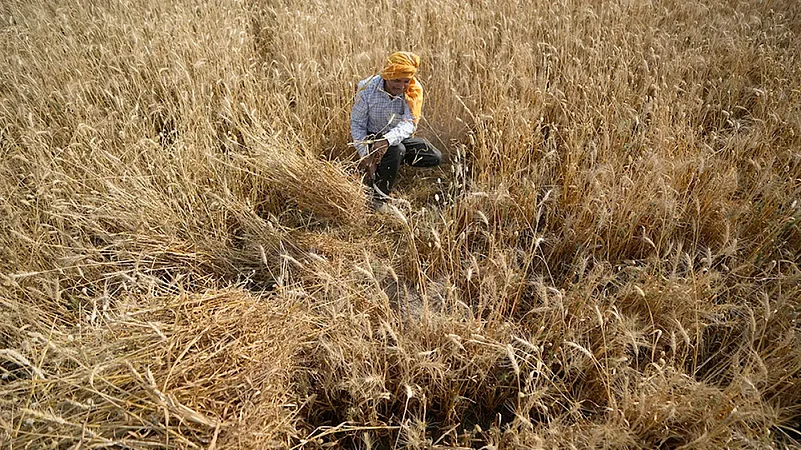The crippling days of food inflation are far from over. While food commodity prices have softened, wheat and rice could still cause concern for the Reserve Bank of India (RBI) ahead of its Monetary Policy Committee meeting.
A Reuters report found that Indian wheat prices jumped to a record high, despite a ban on exports, amid strong demand and dwindling supply from a crop damaged by heat wave. On the other hand, the Russia-Ukraine war disrupted the global supply chains and sent commodity prices soaring. This provided India – the world’s second largest wheat producer -- with an opportunity to capture the void in wheat supply caused by the war -- Ukraine accounted for 12 percent of the total wheat exports in the world.
Advertisement
Why Is Wheat Production Impacted?
Several stakeholders and experts raised concerns that India’s own production and procurement this year was impacted by the heat wave seen across the country. But the government went ahead and allowed export of wheat by the private sector. The decision reportedly fetched farmers 10 per cent higher price than the Minimum Support Price (MSP) of wheat.
But India’s own staggering food inflation soon forced the government to reverse its decision on May 14. June’s retail inflation was at 7.01 per cent, above the RBI’s target range of 2-6 per cent -- India’s retail inflation has been beyond 6 per cent for the sixth consecutive month now. While curb on export of food commodities and softening of edible oil prices slightly eased inflation, it has not been enough to control food inflation. In the food basket, inflation in cereals and products was at 5.66 per cent, meat and fish at 8.61 per cent, and vegetables at 17.37 in June.
Advertisement
As if the soaring inflation caused by a cocktail of global and domestic factors was not enough, a heat wave in March further worsened the price situation for wheat. On July 27, wheat prices in local markets reached a record high of Rs 23,547 per tonne, up almost 12 per cent from the lows it reached recently due to the government's export ban.
The government had an estimate of 106.41 million tonnes of supplies this year -- in 2021, India harvested 109.59 million tones of the crop -- but according to traders, the supply is much low at about 95 million tonnes. The US’ Department of Agriculture's Foreign Agricultural Service has estimated supply to be at 99 million tonnes.
The impact of the March heat wave is also reflected in government’s wheat procurement, which is down 57 per cent this year compared to a year ago, at 18.8 million tonnes.
The government had wrongly estimated excess production which was mainly due to inaccurate intelligence on wheat production and analytics, thereby resulting in misplaced policy decisions such as allowing of exports and eventually banning it.
What Is The Rice Situation?
The government was also relying on paddy to come to the rescue, in case wheat supplies went awry. But paddy is also a cause of concern now. Scattered monsoon since the beginning of June in Bihar, Odisha, West Bengal, and Uttar Pradesh – primary paddy cultivation belts of India - has resulted in lower acreage. Acreage was lower by almost 17 per cent compared to last year, till June.
Advertisement
“Till July 25, out of the 36 subdivisions, only seven received deficient rainfall. However, there has been uneven distribution of rainfall and there is growing concern that this may translate into lower sowing, resulting in lower production. It may even adversely impact food inflation,” a note by Bank of Baroda said.
While monsoon’s revival in these regions have provided hope of paddy planting picking pace, since a significant portion of sowing would happen post peak monsoon, there are concerns over final harvest volumes. In fact, deficient rain has already pushed up prices of rice in the last few days.
Advertisement
In global markets, there is a supply crunch of all food grains. But unlike wheat, India can relatively breathe easy with respect to rice supplies as rice stocks in government’s central pool is more than required.
Rice stocks were almost 134 per cent higher than buffer stock requirements, up to July 1. Stocks in the central pool were around 31.5 million tonnes while the requirement was of 13.5 million tonnes. For the same period, wheat stocks were about 28.51 million tonnes, 1 million tonne above buffer requirements.
Can Wheat Prices Be Controlled In Coming Months?
India has a total of 83.36 million tonnes of rice and wheat in its stocks till July 1, the lowest in the last three years. To manage wheat supplies, the government in May included rice to replace about 5.5 million tonnes of wheat under the Pradhan Mantri Gareeb Kalyan Yojana. Even under the National Food Security Act, the government replaced 6.1 million tonnes of wheat with rice, thus freeing up about 11 million tonnes to keep wheat supplies in check.
Advertisement
The shortage in wheat stocks will push up prices further, thereby worsening food inflation. Wheat, the staple of a large part of India, feeds the majority of India’s marginalized population under the public distribution system. Export curb alone may not be enough this time to reign in prices.















 Just one email a week
Just one email a week